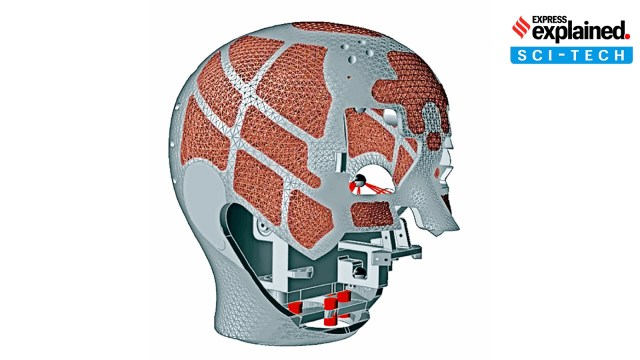The design for Vyomitra’s skull, fashioned by ISRO’s Inertial Systems Unit in the Vikram Sarabhai Space Center in Thiruvananthapuram, Kerala, was finalised recently.

Final skull design with lattice structures. Journal of Institution of Engineers, India
The Indian Space Research Organisation’s (ISRO’s) uncrewed Gaganyaan mission in 2025 will carry the female half humanoid Vyomitra (literally “space friend”). The design for Vyomitra’s skull, fashioned by ISRO’s Inertial Systems Unit in the Vikram Sarabhai Space Center in Thiruvananthapuram, Kerala, was finalised recently.
What are humanoids?
Humanoids (or half-humanoids) are robotic systems designed to resemble humans — Vyomitra comes with movable arms, a torso, a face, and a neck — and function autonomously in space.
In general, robotic systems are used to assist astronauts in performing repetitive and/or dangerous tasks in space, like cleaning of solar panels or fixing faulty equipment located outside the spacecraft. This protects astronauts, and allows them to work on the scientific mission at hand.
Next year’s mission is primarily designed to be a technology demonstration of the Vyomitra. It will see the half humanoid use its robotic arms to perform operations at the crew console, visually monitor various systems inside the crew module, and communicate with the Earth-based mission control team.
ISRO will evaluate the performance of the robot’s technology to measure the likely impacts of space travel on human beings, ahead of India’s first crewed mission planned for later in 2025.
How did ISRO design the humanoid skull for Vyomitra?
The recently-designed Vyomitra skull will house the key components of the robot. It has been made using an aluminium alloy (AlSi10Mg) known for its high flexibility, light weight, heat resistance, and mechanical properties. This alloy is commonly used for making automotive engines and aerospace components.
Crucially, the skull has been designed to be incredibly sturdy, capable of withstanding some extreme vibrational loads that are experienced during a rocket launch. The high strength of the aluminium alloy offers a yield strength of more than 220 MegaPascals (1 MPa = 1 million pascals). Yield strength refers to the maximum stress that can be applied to a material before it begins to deform permanently.
The humanoid skull model has dimensions of 200mm x 200mm, and weighs only 800 grams.
AlSi10Mg is also amenable to the Additive Manufacturing (or AM) technique. This is how the humanoid skull was created. AM enables easy induction of lattice structures, as incorporated in the humanoid skull design. Importantly, it helps in significant reduction of the overall weight of the final product. Unlike conventional manufacturing techniques, AM follows a process in which a desired part or product is created in a layered manner, a commonly deployed mechanism in 3D printing.





Hey, I’m Jack. Your blog is a game-changer! The content is insightful, well-researched, and always relevant. Great job!
Tech to Trick I truly appreciate your technique of writing a blog. I added it to my bookmark site list and will